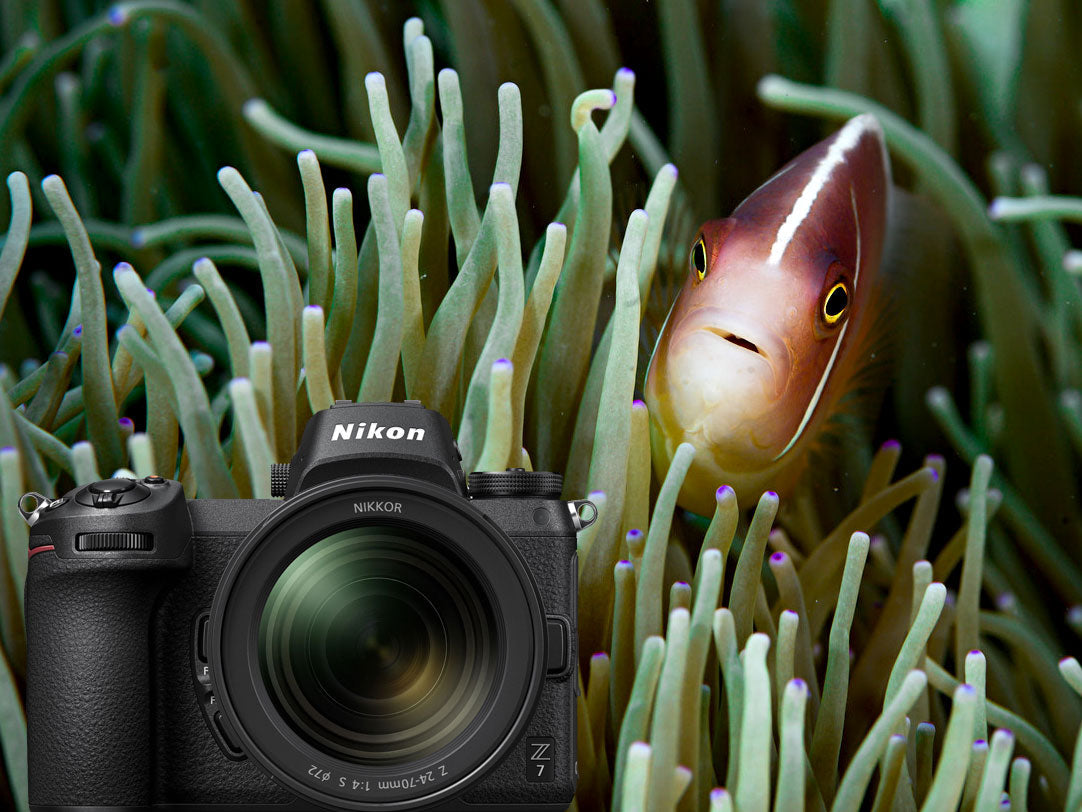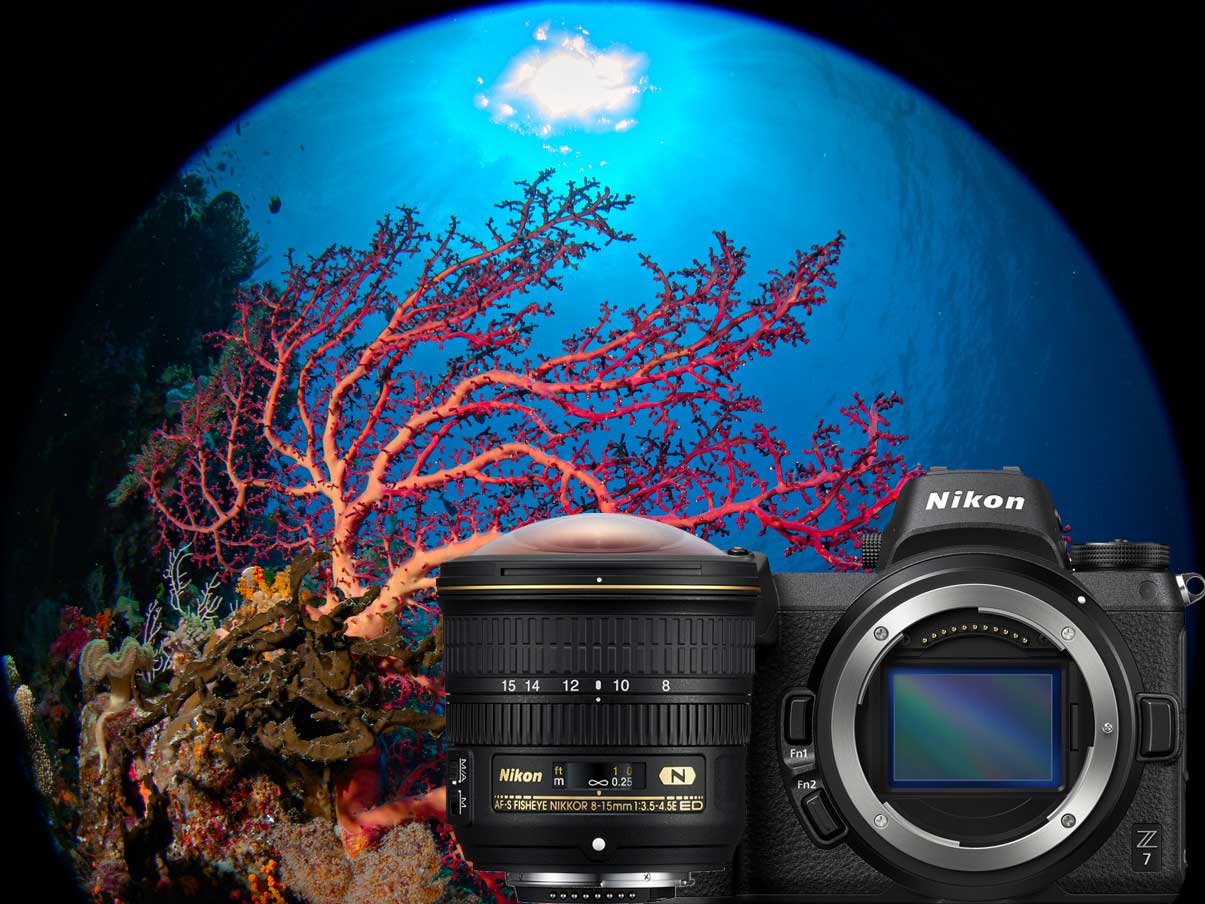By Ambassador Steve Miller
Nikon's Z6 and Z7 full frame mirrorless cameras are two of our favorite newer models for shooting underwater. Both cameras feature awesome dynamic range, fantastic low light (high ISO) performance, have great electronic viewfinders (EVFs), and shoot super sharp 4K ultra HD video.
Part of the allure of a mirrorless full frame camera is the camera's more compact form factor. A Z7 is substantially lighter than lugging around a Nikon D850. There aren't many Z-mount lenses for these newer camera yet, but with the Nikon FTZ adapter you can shoot all of the best Nikon F-mount glass with good speed and accurate autofocus performance.
Our favorite wide angle lens for this system is the Nikkor 8-15mm f/3.5-4.5 Fisheye. It gives a super-wide 180º field of view and is compact and lightweight. It's a little pricey but if you're really concerned about image quality then good glass is the best place you can invest in your rig. The lens has a porthole type circular fisheye effect at 8mm which is great for creative compositions. At the other end is still-wide 15mm with much less distortion of the field of view. The 8-15mm works equally well in the standard DL 8" Dome or the DL Compact 8" Dome. Either port requires an extension for the best overall image sharpness.
The Nikon Z 14-30mm lens is a good choice for wide angle but we found it to be slightly too narrow and edge sharpness isn't as good as with the 8-15mm fisheye.
For macro, the Nikkor 105mm f/2.8 Macro VR lens from your DSLR days is still at the top of the charts. The autofocus works well with the FTZ adapter and you can use the thumb lever for back button focus if you need more control.
These photos were taken at the Wakatobi marine park using the Nikon Z7 full frame mirrorless camera in 200DL Underwater Housing # 71063 with optional 45º Magnified Viewfinder, dual DS161 strobes, and DL1 DS Link TTL Converter.
All photos copyright © 2019 Steve Miller

Nikkor 105mm f/2.8 Macro VR • ISO 200 • f/16 • 1/125 • Smelling the Flowers. The 105mm macro lens is one of the least intrusive lenses we use. The turtle is over 2 feet away from the port here- a comfortable distance for both of us. If the water is really clear, we can shoot a bit farther away and still have sharp detail.

Nikkor 105mm f/2.8 Macro VR • ISO 200 • f/20 • 1/125 • Sexy Shrimp. (That really is what they are called because their tails are always raised.) At about a foot away, the magnification is mild with the 105mm macro- but you can focus inside little caves that a compact camera wouldn’t fit into. Be sure your strobe arms are long enough or short enough to move right next to the port if necessary, other wise you can focus, but your light will miss them or be blocked by the corals.

Nikkor 105mm f/2.8 Macro VR • ISO 200 • f/16 • 1/125 • Some photographers use spot meter and focus all the time anyway, but on a subject as small as this anemone shrimp it is essential for sharpness in the right place.

Nikkor 105mm f/2.8 Macro VR • ISO 200 • f/16 • 1/125 • Bubble Coral Shrimp have translucent bodies, the viewfinder on the Z cameras is so sharp you could use it just for observing these animals up close.

Nikkor 105mm f/2.8 Macro VR • ISO 200 • f/16 • 1/125 • No matter what lens you are carrying, ambush predators like Scorpionfish are perfect subjects- as they would prefer to stay put. Take your first shot farther away than you might want to normalize them to the flash, if you are careful they won’t be bothered by your shooting.

Nikkor 105mm f/2.8 Macro VR • ISO 200 • f/16 • 1/125 • Leaf Fish. Upward camera angles are essential for most wide angle work, but even in a macro image the gradient of the water column can add a visual element to make a shot more interesting.

Nikkor 105mm f/2.8 Macro VR • ISO 200 • f/20 • 1/125 • Crocodile Fish. Another ambush predator, their camouflage can be drab when they lay on sand, but here laying on live corals the colors explode.

Nikkor 8-15mm f/3.5-4.5 Fisheye at 8mm with Compact 8" Dome • ISO 200 • f/14 • 1/125 • To flash or not? In very clear water your flash travels farther- setting your camera to an exposure close to Natural Light allows you to shoot images that are flash lit or not- depending on how close the school gets. If they get really close- you’ll be glad you have your strobe set to TTL, as it will quench the exposure without blowing out the highlights or reflective surfaces.

Nikkor 8-15mm f/3.5-4.5 Fisheye at 15mm with Compact 8" Dome • ISO 200 • f/14 • 1/125 • Small animals like this puffer can be captured with the 8-15mm set to 15mm, but if you want to make them large in the frame you will need to get very close. This is about 4 inches away from a fish about 8 inches long.

Nikkor 105mm f/2.8 Macro VR • ISO 200 • f/16 • 1/125 • Clownfish. The speed at which this camera will focus and capture makes panning fast fish much easier.

Nikkor 105mm f/2.8 Macro VR • ISO 200 • f/16 • 1/125 • Damselfish eggs. Here is the limit of magnification possible without diopters on the 105mm macro. The big files make cropping easier without as much degradation- with or without positive diopters added to the lens.

Nikkor 8-15mm f/3.5-4.5 Fisheye at 8mm with standard 8" Dome • ISO 200 • f/14 • 1/125 • The perspective obtained from the 8-15mm lens is unique; this scene is barely a foot across, and the soft coral is about 4 inches tall. In about 10 feet of water, the Snell effect betrays an almost straight up camera angle

Nikkor 8-15mm f/3.5-4.5 Fisheye at 8mm with standard 8" Dome • ISO 200 • f/14 • 1/125 • Light, color, and texture abound on the reefs of Wakatobi. Use the lens at 8mm to coax shapes that compliment the elements you know are there.

Nikkor 8-15mm f/3.5-4.5 Fisheye at 8mm with Compact 8" Dome • ISO 200 • f/18• 1/125 • The extreme 180 degree view at 8mm means that very small movements in camera angle will change the whole perspective- even the shape of your composition. Find a scene first, then look through the viewfinder and tilt up, down, left right, -some angles will be more pleasing to the eye based on the shapes and their orientation to each other. It will take a long time to be able to “See” like the 8mm Fisheye, so try to find elements that will make a frame around your subject, or reinforce a circular shape.

Nikon Z 14-30mm f/4 S at 14mm • ISO 200 • f/14 • 1/125 • Cuttlefish. There are few moments happier than when you find a Cuttlefish and have a wide angle lens.. (and lots of bottom time and air left!) The 14-30mm is rectilinear, and you can see the corners “pulling” here if you look closely.. some photographers may find this unacceptable.. and honestly I didn’t notice it in this image until one our technicians pointed it out.. for this photographer and this image I like the way it “pulls” my eye to the Cuttlefish.

Nikon Z 14-30mm f/4 S at 14mm • ISO 200 • f/14 • 1/125 • Anemone and Skunk Clownfish. Once you are set up on an anemone like this, it’s time to wait for the fish to be facing you. Using the bright view screen on the Z cameras allows you to hold the system out at a distance, with less fatigue you can look over the top of the housing and pull the shutter whenever you see they are posed nicely.

Nikon Z 14-30mm f/4 S at 30mm • ISO 200 • f/8 • 1/125 • Crinoid. Interesting to note that the corner pulling goes away when the 14-30mm is zoomed to 30mm.

Nikon Z 14-30mm f/4 S at 30mm • ISO 200 • f/10 • 1/125 • This turtle lost his front left flipper somewhere along the way, but still get around pretty well. At 30m he fills the frame, if I had the 8-15mm lens on, I would have had to be much closer (this is around 4 feet away, with the 8-15 I would have needed to be 1-2 feet away).
 Ambassador Steve Miller has been a passionate teacher of underwater photography since 1980. In addition to creating aspirational photos as an ambassador, he leads the Ikelite Photo School, conducts equipment testing, contributes content and photography, represents us at dive shows and events, provides one-on-one photo advice to customers, and participates in product research and development. Steve also works as a Guest Experience Manager for the Wakatobi Dive Resort in Indonesia. In his "free" time he busies himself tweaking his very own Backyard Underwater Photo Studio which he's built for testing equipment and techniques. Read more...
Ambassador Steve Miller has been a passionate teacher of underwater photography since 1980. In addition to creating aspirational photos as an ambassador, he leads the Ikelite Photo School, conducts equipment testing, contributes content and photography, represents us at dive shows and events, provides one-on-one photo advice to customers, and participates in product research and development. Steve also works as a Guest Experience Manager for the Wakatobi Dive Resort in Indonesia. In his "free" time he busies himself tweaking his very own Backyard Underwater Photo Studio which he's built for testing equipment and techniques. Read more...
Additional Reading
Nikon Z6 Full Frame Mirrorless Underwater Photos
In the Water with the Nikon Z6 Full Frame Mirrorless Camera
First Look Nikon Z6, Z7 Mirrorless Underwater Housing
DL1 DS Link Nikon TTL Converter Underwater Photos
Why You Need a Fisheye Lens Underwater
Straight vs 45 Degree Magnified Viewfinder for Underwater Shooting
Close Focus Wide Angle In Depth
Getting it Sharp: Back Button Focus and Post Processing Workflow
Top 3 Best Lenses for Nikon Full Frame Mirrorless Underwater [VIDEO]












![A Celebration of Life with the Sony Alpha A7S II [VIDEO]](http://www.ikelite.com/cdn/shop/articles/celebration-of-life-claude-evangelista-sony-a7s-ii.jpg?v=1645896307&width=2000)
